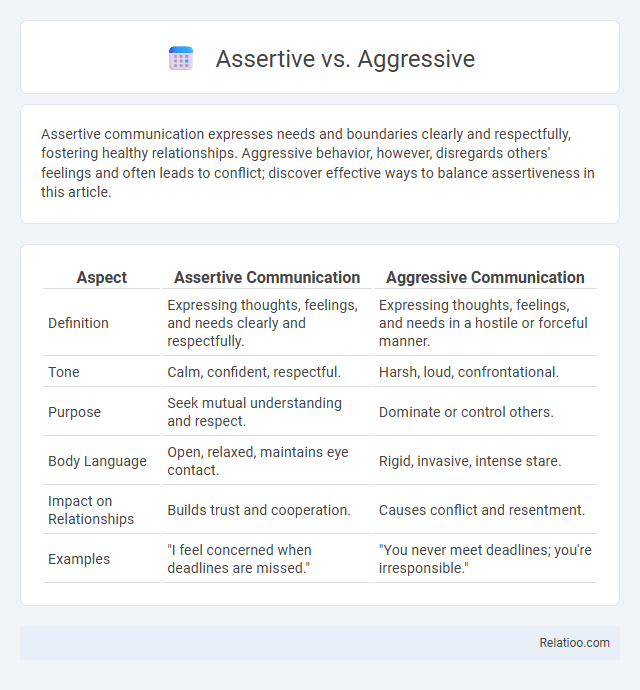Assertive communication expresses needs and boundaries clearly and respectfully, fostering healthy relationships. Aggressive behavior, however, disregards others' feelings and often leads to conflict; discover effective ways to balance assertiveness in this article.
Table of Comparison
| Aspect | Assertive Communication | Aggressive Communication |
|---|---|---|
| Definition | Expressing thoughts, feelings, and needs clearly and respectfully. | Expressing thoughts, feelings, and needs in a hostile or forceful manner. |
| Tone | Calm, confident, respectful. | Harsh, loud, confrontational. |
| Purpose | Seek mutual understanding and respect. | Dominate or control others. |
| Body Language | Open, relaxed, maintains eye contact. | Rigid, invasive, intense stare. |
| Impact on Relationships | Builds trust and cooperation. | Causes conflict and resentment. |
| Examples | "I feel concerned when deadlines are missed." | "You never meet deadlines; you're irresponsible." |
Understanding Assertiveness and Aggressiveness
Assertiveness involves confidently expressing one's thoughts and feelings while respecting others, promoting clear communication and mutual understanding. Aggressiveness, by contrast, disregards others' rights and feelings, often resulting in conflict and hostility. Understanding these differences is crucial for managing power dynamics, fostering healthy interactions, and maintaining balanced relationships in personal and professional settings.
Key Differences Between Assertive and Aggressive Communication
Assertive communication involves expressing thoughts and feelings clearly and respectfully while maintaining personal boundaries, promoting mutual understanding and collaboration. Aggressive communication disregards others' rights and feelings, often using intimidation, blame, or hostility to dominate interactions and exert power control. The key difference lies in intent and impact: assertiveness seeks equitable dialogue and positive outcomes, whereas aggression prioritizes winning or control at the expense of relationships.
Signs of Assertive Behavior
Signs of assertive behavior include clear and direct communication, maintaining steady eye contact, and expressing thoughts and feelings confidently without infringing on others' rights. Assertive individuals use calm and respectful tones, set boundaries effectively, and listen actively to others' perspectives. This behavior promotes mutual respect and balanced power dynamics in interpersonal interactions.
Common Traits of Aggressive Behavior
Aggressive behavior often includes traits like hostility, dominance, and a tendency to impose one's will on others without regard for their feelings or boundaries. This behavior can manifest through verbal attacks, physical intimidation, or coercive tactics designed to control or overpower. Understanding these common traits helps you recognize when power dynamics become unhealthy and differentiate aggression from assertiveness.
The Importance of Being Assertive in Daily Life
Being assertive fosters clear communication and mutual respect, essential for maintaining healthy power dynamics in daily interactions. Unlike aggressive behavior, which can damage relationships, assertiveness allows individuals to express their needs and boundaries effectively without infringing on others. Developing assertiveness enhances personal confidence and promotes cooperation, making it a crucial skill for both personal and professional success.
Negative Impacts of Aggressiveness
Aggressiveness often leads to strained relationships, increased conflict, and a hostile environment that undermines effective communication and trust. Unlike assertiveness, which promotes clear and respectful expression of your needs, aggressiveness can cause others to feel threatened, disrespected, and defensive, damaging collaborative efforts. Understanding the negative impacts of aggressiveness helps you cultivate healthier power dynamics and more constructive interpersonal interactions.
Benefits of Assertive Communication
Assertive communication enhances your ability to express thoughts and feelings clearly while respecting others, fostering mutual understanding and trust. This style promotes healthy power dynamics by balancing confidence without hostility, reducing conflicts and increasing collaboration. Cultivating assertiveness improves relationships, decision-making, and personal empowerment in both professional and personal environments.
Real-Life Examples: Assertive vs Aggressive Responses
Assertive responses involve clear, respectful communication where you express your needs confidently without infringing on others' rights, such as calmly stating your opinion in a team meeting. Aggressive responses, by contrast, often involve hostility or dominance, like interrupting colleagues or raising your voice to impose your views. Understanding these distinctions helps you navigate power dynamics effectively, ensuring your interactions promote respect rather than conflict.
Tips for Becoming More Assertive without Being Aggressive
To become more assertive without being aggressive, practice clear and calm communication that respects both your needs and others' boundaries. Use "I" statements to express feelings and desires without blaming, maintaining a balanced tone to prevent dominance or hostility. Developing active listening skills and recognizing power dynamics helps foster mutual respect and effective dialogue.
Assertive Communication Skills for Healthy Relationships
Assertive communication skills empower individuals to express their thoughts and feelings clearly and respectfully, fostering mutual understanding and trust in healthy relationships. Unlike aggressive communication, which can alienate or intimidate others, assertiveness balances confidence with empathy, promoting open dialogue and conflict resolution. Developing assertive communication enhances emotional intelligence and supports equitable power dynamics by ensuring all parties feel heard and valued.

Infographic: Assertive vs Aggressive
 relatioo.com
relatioo.com